Everybody stopped what they were doing when Hubert came to town. Memories of my meeting this cavalier German in Corvallis, OR, and a crazy road trip I took with him to New York City are fixed like ants in fossilized amber and just as visible through the yellowed years.
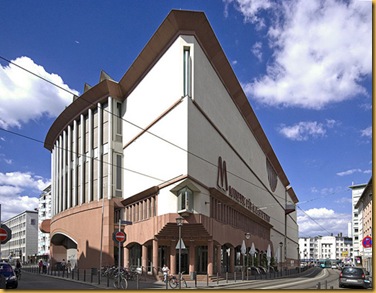 Museum of Modern Art, Frankfurt am Main
Museum of Modern Art, Frankfurt am Main
Hubert was a graduate student at the University of Frankfurt at the time, studying the ways the artist Edward Hopper captured the alienating forces of modernity that were reaching their zenith in the 1920’s and ‘30’s. And, like many young transcendental romantics from crowded Europe who imagine wearing cowboy boots and ten gallon hats, Hubert was smitten by the American West. Its wide open spaces, lacking in Europe, offered decompressing relief from the constipating effects of post industrial consumerism in the modern western nation states. “Howdy, podner,” he began a letter to me once.
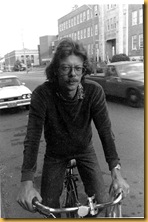 My friends became Hubert’s mentors of American culture when he attended Oregon State University as a foreign exchange student. Helping to fuel his dry wit, they taught him the meaning of American colloquialisms. He asked about the expression “so and so ‘got screwed,’” for instance. After being told, Hubert peppered his rollicking language with this deprecating remark to which he added the postscript, “only slightly though.” My friends adored him.
My friends became Hubert’s mentors of American culture when he attended Oregon State University as a foreign exchange student. Helping to fuel his dry wit, they taught him the meaning of American colloquialisms. He asked about the expression “so and so ‘got screwed,’” for instance. After being told, Hubert peppered his rollicking language with this deprecating remark to which he added the postscript, “only slightly though.” My friends adored him.
I finally met Hubert when I flew in on a few weeks furlough from a wilderness camp counseling stint in North Carolina. A party lasting three weeks had taken us for a day to the Oregon coast. I’m on the left in the picture below. Hubert is kneeling.
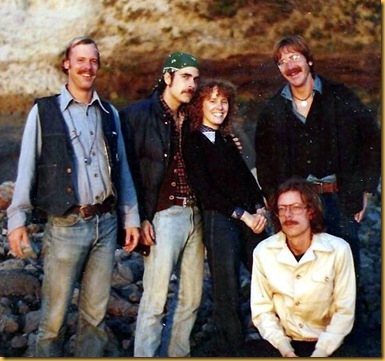
Some years later Hubert flew from Frankfurt to New York and then hitched across the country to Corvallis. It was during a time of tumult and general disaffection in my Corvallis crowd. Old cohabiting couples were breaking up. My friends in Iron Rose, a loose confederation of anarchists, were pamphleteering patrons of the coffee counter cultures at Sambo’s and the Big “O” restaurants to rally behind waitresses and other oppressed wage slaves, but were growing disillusioned with the lack of public response. Others belonging to the “lumpen intelligentsia” were feeling growing pains and spoke of trying out new intellectual and artistic horizons in Portland and New York City. But Hubert’s arrival forced a freeze frame in the film followed by a frolicking free-for-all that lasted two weeks. He just had a way of doing that.
 Inside the Museum of Modern Art, Frankfurt
Inside the Museum of Modern Art, Frankfurt
Toward the end of his stay, Hubert described to us over beer at Squirrel’s Tavern in downtown Corvallis how he had found a way to get to the east coast for free before boarding a plane back to Germany. He was going to drive a VW bug belonging to a professor who was soon moving, along with his family, to Princeton, New Jersey. The owner had just given him $300 to pay for expenses, beginning with, I suppose, the cost of a round of beer as Hubert announced his intentions. I stopped and stared at the bar table, the conversation becoming a dim rumble in my ear, in my sudden realization that I was going to get into that car with him. I had incentives. The degree in science education I had returned to Corvallis to earn wasn’t producing any job offers that fall. And, like the protagonist played by Matt Damon in the movie Good Will Hunting, who leaves job prospects in Boston for Palo Alto, California, I had “to see about a girl” in Illinois with whom I had been corresponding.
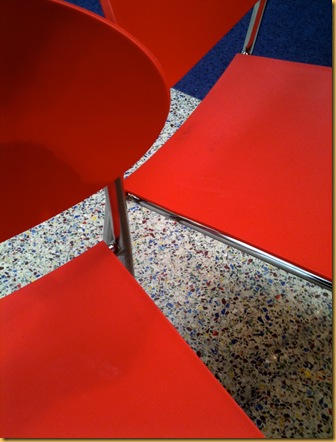
Playful mockery of bland mainstream status quo society quickly became the modus operandi of our cross-country boondoggle. We decided to document our journey on yellow legal pad paper at rest stop coffee counters, which quickly received copy write status,
HUBERTANTICS ©
For instance, we cut up the ticket a cop wrote when he busted Hubert in a Safeway parking lot for peeing in the bushes, and pasted its parts into our travel log to especially document the number of people the citation stated Hubert had offended with this behavior. The officer had "reasonable grounds for believing that said offense against ordinance 841.7-1, Urinating in public, was committed by the Defendant against the peace and dignity of the City and County of Denver, and the people of the state of Colorado.” The demand for justice on the part of that many people necessitated in no uncertain terms that the rights of the Defendant be protected. So we checked 846.5-4, Unlawful to give false information, and role-played the following scenario.
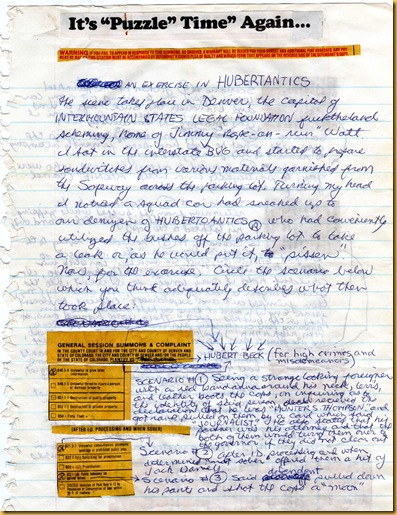
“Seeing a strange looking foreigner wearing a red bandanna around his neck, Levi’s, and leather boots (‘Howdy, podner’), the cops, on inquiring as to the identity of said person, were told he was Hunter S. Thompson. Defendant then pulled rank by shoving a card into their faces, which said, ‘Bonzo Journalist.’ Defendant stated that his partner was his attorney, who told both cops that they would be turned over to the governor if they didn’t clear out pronto.”
“We continue to journey into the core of the Great Amerikan Mistake,” Hubert wrote. “There’s Dwight D. Eisenhower’s boyhood home. He symbolizes the ’50’s, the enormous decade of monstrosity revisited, which leaves us helpless, helpless, helpless, of course....starry night auf der Autobahn and sticking human bodies into that metallic apparition dependent on combustion. Corn, corn, prairie, cattle, gas station, billboard, irrigation madness, grain elevator reinforced by church without steeple, rising to the point of burnt eyes, burnt stomach, burnt cigarette, you betcha.”
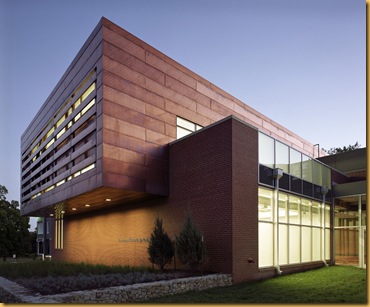
Lawrence Kristina Dodge building Kansas City Art Institute
Hubert wanted to hang out with the painters who were pulling an all-nighter in their studio at the Kansas City Art Institute.
Ironically, 27 years later, my recollection of such an intense commitment to their art, and recognition of that same intensity in one of my students at the Chicago Academy for the Arts, helped get her accepted there. “I watched students at KCAI in all night studio marathons. She'd fit right in,” I wrote on her behalf.
In Columbia, MO, our bonzo journalist bought a tape recorder. At a local diner, he orally observed the following.

“The tension has risen to the point where the employees keep dropping the china and overreact by madly polishing the chrome stools. The hostess has just started to take off her clothes. We are determined not to take such bullshit, and give her that ‘Hey, that’s kind of you’ grin, which makes her considerably nervous. She starts punching absurd codes into the cash register only to make it spit out coins, and yells, ‘Jackpot! Jackpot!’ Amused, we munch on the half-and-half containers like jelly beans until the creamy drooling is all over the place, and try to figure out the relationship between chrome, jelly beans, and the presidency.”
On the campus of the University of Missouri, Hubert introduced himself to a group of art majors painting watercolors on the lawn, and gave a lecture. One of them, “Lisa,” reluctantly mentioned that she had a boyfriend. “Sad Lisa. Oh Lisa, Lisa, sad Lisa, Lisa...”
On the way to St. Louis, we discussed the popular genre of literature about post-apocalyptic survivorship and personal redemption, retelling on tape the dystopia tale of the The Time Machine by H. G. Well’s, of the reluctant hero Max Rockatansky, played by Mel Gibson, who attempts to save a surviving remnant from marauders in The Road Warrior, and the Nebula Award-winning novella of A Boy and his Dog.
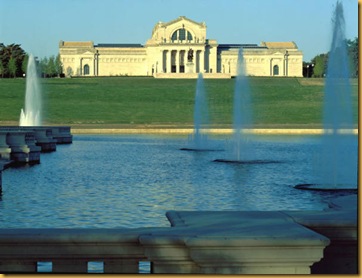
St. Louis Art Museum, St. Louis, Missouri
Hubert’s left-leaning eye triggered a litany of one-line commentary. Seeing the St. Louis Arch, Hubert suggested that, “There’s got to be more,” because, like the Golden Arches © in our consumer culture, “Two is better than one.” Visiting the St. Louis Art Museum, he remarked on seeing a cherub holding a compass, a protractor, and a plumb bob, “Yes, implements of the technocratic imperative.” Gaudy paintings of Americans clad in flowing folds of Greek garb symbolized “Manifest Destiny.” Hubert quoted a bumper sticker clandestinely stuck to a trash can in the hallway, “Death to Corporate Capitalism.” He was quick to notice a statue of Siegfried of the great Nordic myth, who represents the human (er, German super) race, which, at the dawn of history, is just coming into its own in ascendancy over the gods. Later, commenting on a skewing of class identity, Hubert remarked that soccer in Europe is a sport of the lower classes, while, here, he noticed suburban middle and upper class youth everywhere playing the game.
"Uh oh. Dave's getting nervous," Hubert said. The “girl” I had to see about lived in Urbana, IL, and the road sign said it was near. We were to stop by before she and her date were to see a movie. “Her date?” asked Hubert. “Sounds like her fruit. Hey, don’t worry about the trauma of crashing her date. See, over there? Trauma Center.”
We sat on her living room floor. She eyed me as I recited the time I gave Dave Foreman, co-founder of the radical environmental group Earth First! a ride to Eugene, Oregon for a recruiting lecture, and continued politely to sip her wine with her date. Little did either Hubert or I know that I would eventually be married to her for twenty years.
On the way to Chicago, Hubert suggested that I acquire a little “patina” by downing some Jack Daniels we got when leaving Urbana, which smoothed the way out of the “trauma” of interrupting her date, and helped facilitate the distracting relief of a half hour drunken recitation of McMurtry’s The Last Picture Show.
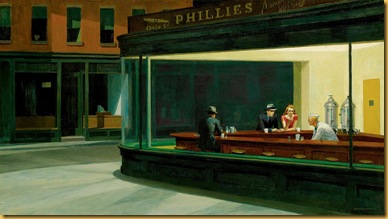
For Hubert, going to see Edward Hopper’s Nighthawks at the Art Institute of Chicago was like embarking on a pilgrimage to Mecca.
An American friend of his attended the Art Institute. We crashed the place that she and a rabble of international roommates literally were crashing themselves rent free, an old, abandoned warehouse with broken windows that somehow never had the heat turned off. So they weren’t paying for the heat, either. They had no furniture, slept on the floor, each separated by walls that were just two-by-fours without drywall, and ate out of electric frying pans on the floor. We all went shopping after midnight to prepare an elaborate international meal that we ate at 3 am. German, American, Irish, and Scottish partiers laughed, drank, and told stories, reminding me of Kierkegaard’s The Banquet in his great treatise of a proposed sequence in character development, Stages on Life’s Way.
It was my first time visiting New York City as an adult. We stayed with Corvallis acquaintances, a couple consisting of an Oregon State English professor on sabbatical to write novellas, and his wife, a student at Pratt Institute. Their apartment was over the Good Luck Grocery along Myrtle Avenue in Brooklyn. I quickly learned that the bustling streets there can be dangerous places when I pulled out my buck knife to punch open a pop can with a broken tab. People on the street froze and stared. Even the coin laundries had burly changers who were there actually to guard the change.

Over a period of four days, we migrated between Manhattan and Brooklyn, each day ending with a hard crash at 5 am. We hung out at St. Mark’s and Washington Squares. Hubert and I wandered in the Metropolitan Museum of Art and The Whitney Museum, home of Hubert’s beloved Hopper. We drank Rolling Rock at the Red Bar near Cooper’s Union, admiring the early ‘80’s new wavers with their Hitler cuts or swept back long hair, shaven on both sides, and peg legs. We waited until 1 am to hear the main act at the Peppermint Lounge, The Jim Carroll Band. People sported t-shirts with the logo of the band The Dead Kennedy’s. The sound system’s base capabilities made us resonate down to the nuclei of our molecules.
But you better get ready
If you're going to Freddy's
If you're going to Freddy's store
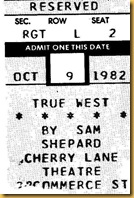
We saw the film Badlands on the upper east side, starring Sissy Spacek and Martin Sheen, and attended opening night of an off-Broadway Sam Shepard play, True West, starring John Malkovich, at the Cherry Lane Theater in Greenwich Village.
Hubert returned to Frankfurt, and I took a bus far enough west into New Jersey so that I could start hitch hiking back to Oregon. The makeshift sign I posted for drivers-by read, “Urbana, IL.” There I stayed with my future wife for a week before getting back on the road. The match between us may have already been struck, but the trip, replete with a hitch across the country to Oregon identical to Hubert’s, was like an enzyme catalyzing a too-slow chemical reaction by lowering the activation energy needed for it to flame up at low temperatures.
I’ll blame that on Hubert.
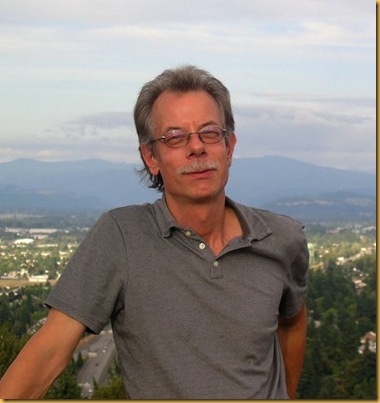
POSTSCRIPT. It is late February, 2012. I just got word of Hubert’s premature passing, apparently of an accidental overdose of a sleeping medication. It is a time of mourning. My resolve is to commemorate my friend and how he changed my life with a fitting memorial the likes of which I am sure you can guess..............In the words of Jim Belushi of Animal House fame:
ROAD TRIP

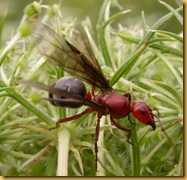

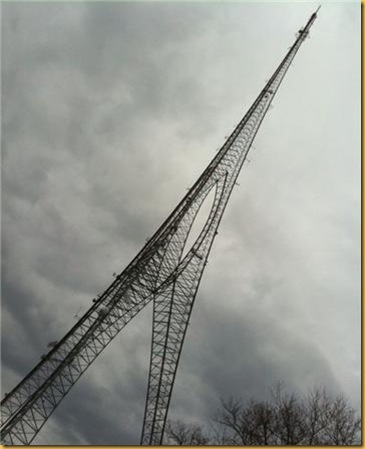


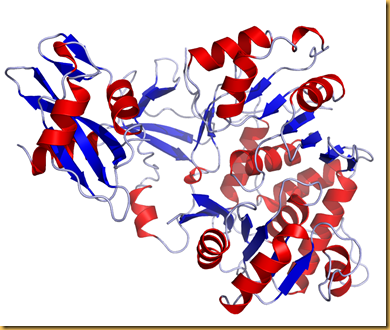
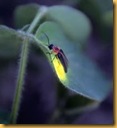
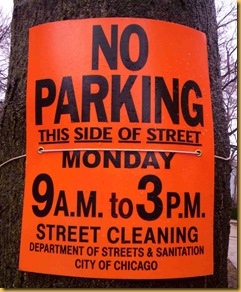
















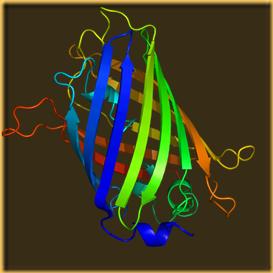


![untitled[3] untitled[3]](http://lh4.ggpht.com/_7iqXfeuYuO4/S5QylaviqyI/AAAAAAAAAY8/9Re63DebAKo/untitled3_thumb6.jpg?imgmax=800)
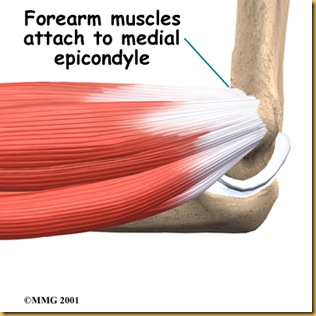
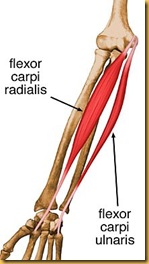

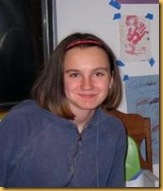
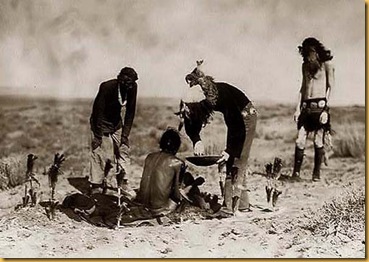
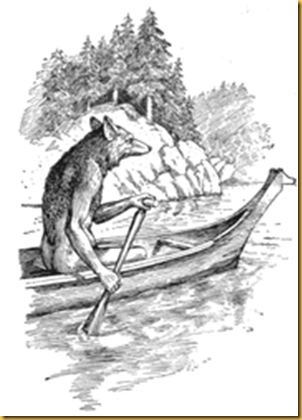

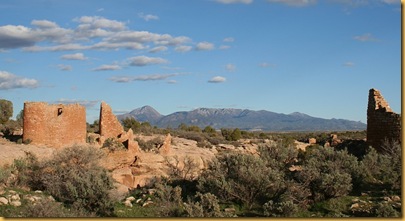

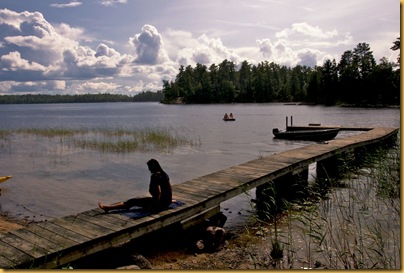
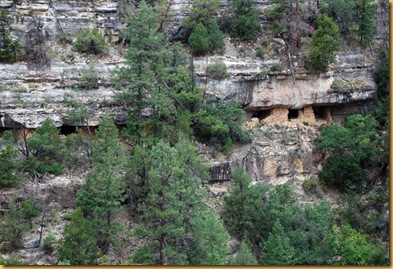


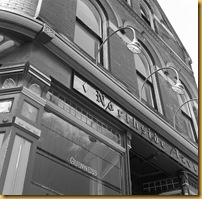

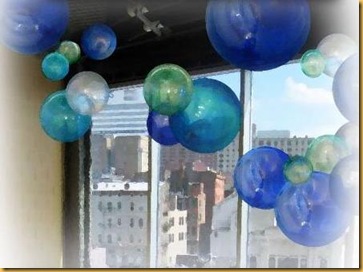
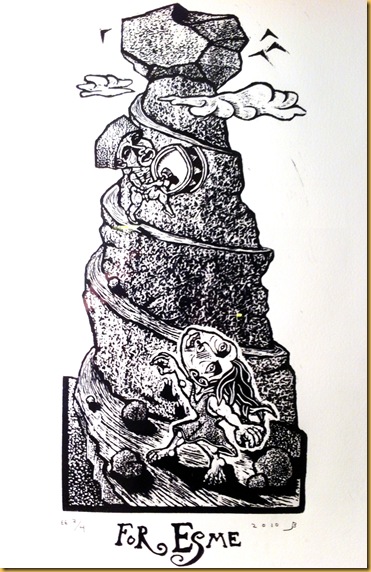
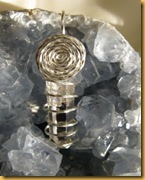
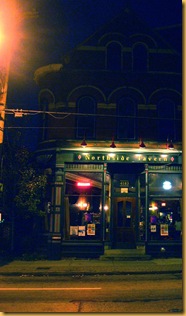
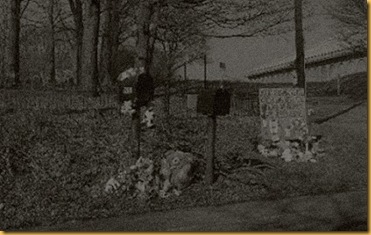 Adorned mailbox, roadside memorial, and the distant reservoir
Adorned mailbox, roadside memorial, and the distant reservoir